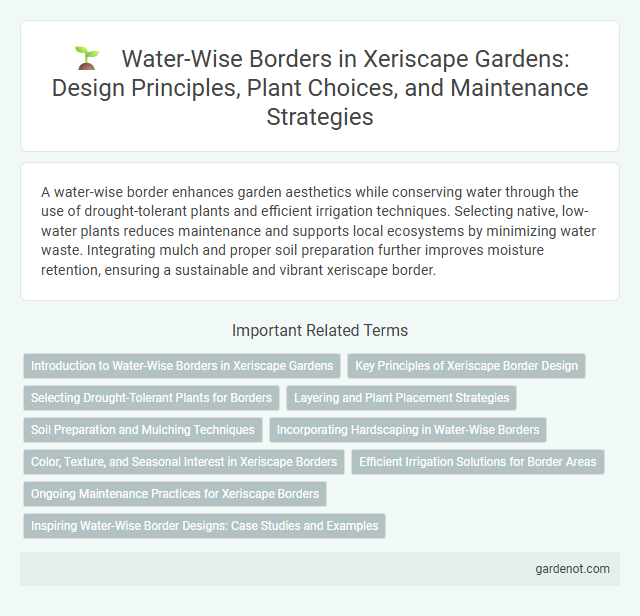A water-wise border enhances garden aesthetics while conserving water through the use of drought-tolerant plants and efficient irrigation techniques. Selecting native, low-water plants reduces maintenance and supports local ecosystems by minimizing water waste. Integrating mulch and proper soil preparation further improves moisture retention, ensuring a sustainable and vibrant xeriscape border.
Introduction to Water-Wise Borders in Xeriscape Gardens
Water-wise borders in xeriscape gardens utilize drought-tolerant plants and efficient irrigation techniques to minimize water consumption while maintaining aesthetic appeal. These borders often feature native grasses, succulents, and deep-rooted perennials that thrive in arid conditions, enhancing soil retention and reducing runoff. Strategic placement of mulch and drip irrigation systems supports sustainable water management, promoting healthy plant growth with minimal waste.
Key Principles of Xeriscape Border Design
Water-wise border design in xeriscaping emphasizes drought-tolerant plants, efficient irrigation, and soil improvement to minimize water use. Grouping plants by water needs and incorporating mulch reduces evaporation and maintains soil moisture. Strategic plant selection and placement optimize aesthetics while conserving water resources effectively.
Selecting Drought-Tolerant Plants for Borders
Selecting drought-tolerant plants for water-wise borders enhances xeriscape efficiency by minimizing irrigation needs. Native species like lavender, succulents, and ornamental grasses thrive in low-water conditions while maintaining aesthetic appeal. Incorporating deep-rooted perennials improves soil health and moisture retention, promoting sustainable garden borders.
Layering and Plant Placement Strategies
Effective xeriscape water-wise borders rely on strategic layering and plant placement to maximize water retention and minimize irrigation needs. Grouping plants with similar water requirements and arranging drought-tolerant species in deeper layers ensures efficient soil moisture absorption and reduces evaporation. Incorporating native perennials, ornamental grasses, and mulch in alternating layers further enhances water conservation in landscape design.
Soil Preparation and Mulching Techniques
Water-wise borders thrive with well-prepared soil that improves drainage and retains moisture effectively. Incorporating organic matter like compost enhances soil structure, promoting healthy root growth in xeriscape plants. Applying a 2-3 inch layer of mulch reduces evaporation, suppresses weeds, and stabilizes soil temperature, ensuring efficient water use in drought-tolerant landscapes.
Incorporating Hardscaping in Water-Wise Borders
Incorporating hardscaping elements such as gravel paths, stone edging, and permeable pavers into water-wise borders enhances drought resistance and reduces irrigation needs. These materials improve soil moisture retention and minimize water runoff, creating an efficient, low-maintenance xeriscape. Strategic placement of hardscape components also supports native, drought-tolerant plants by providing structural stability and optimal growing conditions.
Color, Texture, and Seasonal Interest in Xeriscape Borders
Water-wise borders in xeriscape designs combine drought-tolerant plants with vibrant color, varied texture, and compelling seasonal interest to create visually appealing landscapes. Incorporating native species like lavender, sedum, and ornamental grasses introduces a dynamic mixture of foliage patterns and flowering periods that reduce water use while enhancing aesthetic appeal. Strategic layering of plants ensures continuous bloom cycles and textural contrast, optimizing the border's ecological efficiency and artistic value.
Efficient Irrigation Solutions for Border Areas
Water-wise borders utilize drip irrigation systems and soaker hoses to deliver precise moisture directly to plant roots, minimizing water waste in xeriscape gardens. Efficient irrigation solutions incorporate moisture sensors and timers to optimize watering schedules, ensuring consistent hydration without overwatering. Native and drought-tolerant plants in these border areas further reduce water demand, enhancing overall landscape sustainability.
Ongoing Maintenance Practices for Xeriscape Borders
Water-wise xeriscape borders require ongoing maintenance practices such as regular inspection for drought stress and efficient irrigation system calibration to prevent water waste. Pruning and mulching help retain soil moisture while controlling invasive weeds enhances plant health and water efficiency. Monitoring soil moisture levels and adjusting watering schedules seasonally ensure optimal plant growth with minimal water use.
Inspiring Water-Wise Border Designs: Case Studies and Examples
Water-wise border designs showcase drought-tolerant plants like lavender, ornamental grasses, and succulents to create sustainable, low-maintenance garden edges. Notable case studies highlight how combining native species with efficient drip irrigation systems drastically reduces water consumption by up to 50%. These examples demonstrate the effectiveness of xeriscaping principles in transforming traditional borders into vibrant, eco-friendly landscapes.
Water-wise border Infographic

 gardenot.com
gardenot.com